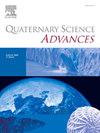Demarcating paleoflood repositories using documentary evidence and flood geomorphic landforms
IF 2.2
Q2 GEOGRAPHY, PHYSICAL
引用次数: 0
Abstract
A reconstruction of paleoflood stages reflects the magnitude and frequency of historic floods. Sediment-filled landforms store centuries-old paleoflood data, allowing examination of past events, though river changes and human activities can obscure these valuable records. Hence, identifying the plausible locale for collecting the sediment core is cumbersome. The present research proposes a methodological approach for precisely identifying the repositories. The Cauvery Delta, the largest sediment deposit on Tamil Nadu's eastern coast, is chosen for the study. The study's methodology is structured into: (1) reconstructing a catalogue of significant flood events using documentary records; (2) mapping fluvial geomorphic landforms using satellite images; (3) spatially correlating the records obtained from documentary sources with landforms, and (4) identifying flood geomorphic landforms (FGL) and demarcating promising prospective locales for future chronological studies. It has been observed that the Cauvery River has experienced recurrent instances of flooding throughout the past 8000 years. The FGL mapped using digitally processed satellite images displayed 17 types of landforms. Subsequently, the FGL are precisely identified by spatially integrating documentary data with landforms. Braided bar, channel bar, lateral bar, channel islands, natural levees, paleochannels, older flood plains, point bars, oxbow lakes, and water bodies are the most promising FGL for paleoflood research.
利用文献证据和洪水地貌地貌划分古洪水库区
古洪水阶段的重建反映了历史洪水的规模和频率。充满沉积物的地貌储存了数百年前的古洪水数据,可以用来研究过去的事件,尽管河流的变化和人类活动可能会掩盖这些宝贵的记录。因此,确定收集沉积物岩心的合理地点是很麻烦的。本研究提出了一种精确识别存储库的方法。泰米尔纳德邦东海岸最大的沉积物沉积物库弗里三角洲被选为研究对象。本研究的方法包括:(1)利用文献记录重建重大洪水事件的目录;(2)利用卫星影像测绘河流地貌地貌;(3)将文献记录与地形进行空间关联;(4)识别洪水地貌(FGL),为未来的年代学研究划定有前景的地点。据观察,在过去的8000年里,高韦里河经历了反复的洪水事件。FGL地图使用经过数字处理的卫星图像,显示了17种地形类型。随后,通过文献数据与地形的空间整合,精确识别FGL。辫状坝、河道坝、侧坝、河道岛、天然堤防、古河道、古洪泛平原、点坝、牛轭湖和水体是古洪水研究最有前途的FGL。
本文章由计算机程序翻译,如有差异,请以英文原文为准。
求助全文
约1分钟内获得全文
求助全文
来源期刊

Quaternary Science Advances
Earth and Planetary Sciences-Earth-Surface Processes
CiteScore
4.00
自引率
13.30%
发文量
16
审稿时长
61 days
 求助内容:
求助内容: 应助结果提醒方式:
应助结果提醒方式:


